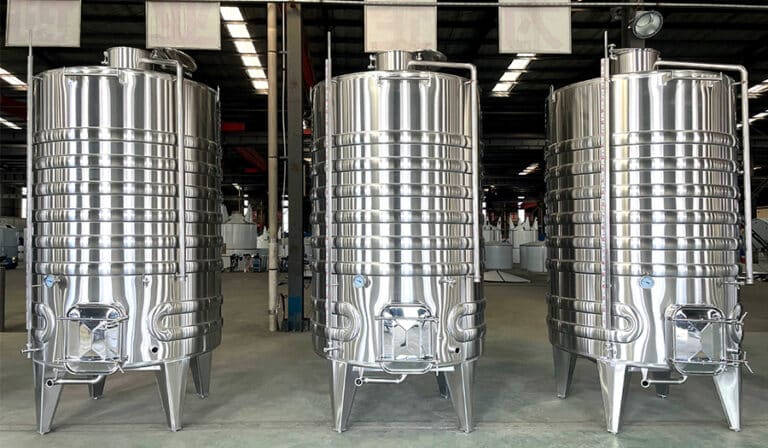In de wereld van het wijnmaken is fermentatie een cruciaal proces dat een directe invloed heeft op de smaak, het aroma en de uiteindelijke kwaliteit van de wijn. Traditionele wijnfermentatie maakt gebruik van houten vaten, maar met de vooruitgang van de wijntechnologie zijn roestvrijstalen fermentatietanks geleidelijk aan de keuze van veel wijnmakers geworden. Dus, kunnen roestvrijstalen fermentatietanks worden gebruikt om wijn te fermenteren? Het antwoord is duidelijk ja. Roestvrijstalen fermentatietanks kunnen niet alleen gebruikt worden om wijn te fermenteren, maar hebben ook veel voordelen die traditionele houten vaten niet kunnen evenaren.
Wat is een wijngistingstank?
A wijngistingstank is een roestvrijstalen vat dat wordt gebruikt om druivensap te fermenteren. Het is corrosiebestendig, gemakkelijk schoon te maken en heeft een stabiele temperatuurregeling. De belangrijkste functie van de fermentatietank is om de gist te ondersteunen bij het omzetten van de suiker in het druivensap in alcohol en kooldioxide.
Soorten fermentatietanks:
- Open fermentatietanks: De meeste commerciële wijnhuizen gisten rode wijn in open tanks om de warmte te laten ontsnappen en het deksel toegankelijker te maken. Als je vergist op de schillen, zullen de schillen naar boven drijven en aan het deksel blijven plakken. Dit deksel beschermt de wijn tegen wind en regen, maar het moet ook af en toe terug in de wijn worden gedrukt om meer smaak- en aromacomponenten uit de schillen te halen.
- Gesloten gisttanks: Gesloten wijngistingstanks worden gebruikt voor niet-oxidatieve wijngisting. Dit type gistingstank is het meest geschikt voor witte wijnen. De bovenkant van de tank blijft verzegeld tijdens de gisting en een inert gas zoals stikstof wordt gebruikt om de hoofdruimte in de tank te vullen en zuurstof te vervangen. Op deze manier gebrouwen wijnen hebben een frisse smaak en zijn geschikt om vroeg te drinken.

Materiaalsoorten die worden gebruikt in wijngistingstanks
Eik
Met eiken vaten stroomt zuurstof langzamer in de wijn. Hierdoor worden de tannines van de wijn zachter. Daarnaast heeft de mate van roosteren van de eikenhouten vaten ook invloed op de smaak van de wijn. De vaten kunnen aroma's en smaken zoals vanille, kruiden en rook aan de wijn afgeven, wat de complexiteit van de wijn ten goede komt. De vaten laten een kleine hoeveelheid zuurstof toe, wat de wijn helpt rijpen en, door gisting, de wijn zachter en mellow kan maken.
Beton
Betonnen tanks zijn er in verschillende vormen, zoals vierkant, rechthoekig of eivormig. Sommige tanks zijn open, terwijl andere goed afgesloten zijn om te voorkomen dat er zuurstof in de wijn komt. Beton geeft de wijn een neutrale smaak, maar soms kan het de wijn ook een minerale smaak geven.
Roestvrij staal
Roestvrij staal is een van de meest gebruikte materialen in de moderne wijnproductie. Wanneer de tanks niet in gebruik zijn, blijven ze gesloten. Inert gas vult elke ruimte in de tank en vervangt zuurstof. Roestvrij staal geeft ook geen unieke smaken af aan de wijn. Roestvrijstalen tanks zijn een uitstekende keuze voor wijnen die koud moeten worden gehouden tijdens de gisting, omdat ze de beste koeling bieden.
Plastic tanks
Kunststof tanks worden over het algemeen gebruikt voor kleinschalige thuiswijnbereiding of in de vroege stadia van wijngisting. Kunststof kruiken zijn licht en gemakkelijk mee te nemen. Vergeleken met andere materialen is plastic goedkoper en minder breekgevoelig, maar het is minder duurzaam en vatbaarder voor bacteriën.
Voordelen van roestvrijstalen rode wijn fermentatietanks
- Temperatuurregeling: Roestvrijstalen gistingstanks zijn meestal uitgerust met een temperatuurregelingssysteem dat de gistingstemperatuur op tijd kan aanpassen. Dit helpt wijnmakers om een ideale omgeving te behouden tijdens het gistingsproces, zodat de gist op de optimale temperatuur werkt en het gistingseffect verbetert.
- Gemakkelijk schoon te maken en te onderhouden: Het oppervlak van roestvrijstalen materialen is glad en zeer gemakkelijk schoon te maken. Houten vaten zijn echter gevoelig voor achtergebleven vuil tijdens het reinigingsproces, wat kan leiden tot de groei van diverse bacteriën tijdens het gistingsproces. Daarom kan het gebruik van roestvrijstalen fermentatietanks het risico op besmetting verminderen en de zuiverheid van de wijn garanderen.
- Sterke weerstand tegen corrosie: Roestvrij staal wordt niet gemakkelijk aangetast door zure stoffen en andere stoffen, dus het zal de smaak van de wijn niet aantasten door langdurig gebruik zoals houten vaten. Hierdoor presteren roestvrijstalen tanks goed tijdens langdurige opslag en gisting.
- Korte gistingscyclus: Roestvrijstalen tanks hebben een goede thermische geleiding en kunnen de activiteit van gist bevorderen. Vergeleken met traditionele houten vaten kunnen roestvrijstalen tanks de gistingscyclus verkorten en de efficiëntie van het wijnmaken verbeteren.
- Hoge transparantie: Veel roestvrijstalen tanks zijn uitgerust met kijkvensters, zodat wijnmakers het gistingsproces op elk moment kunnen controleren en relevante parameters op tijd kunnen aanpassen. Dit biedt wijnmakers meer flexibiliteit en controle.
- Kosteneffectiviteit: Vergeleken met eikenhouten vaten zijn roestvrijstalen vaten over het algemeen voordeliger. Ze gaan langer mee en vergen minder onderhoud. Reserveafsluiters en andere vatonderdelen zijn altijd online verkrijgbaar.

Kunnen roestvrijstalen gisttanks rode wijn vergisten?
Ja, roestvrijstalen fermentatietanks kunnen worden gebruikt om rode wijn te fermenteren en zijn een veelgebruikt apparaat geworden in de moderne wijnproductie.
- Temperatuurregeling: Roestvrijstalen gistingstanks zijn meestal uitgerust met geavanceerde temperatuurcontrolesystemen, die essentieel zijn voor het gistingsproces van rode wijn. De optimale temperatuur voor de gisting van rode wijn ligt meestal tussen 20°C en 30°C. Door de temperatuur nauwkeurig te regelen, kan ervoor worden gezorgd dat de gist in de beste conditie werkt, waardoor de vorming van smaak en aroma wordt bevorderd.
- Controleerbaarheid en flexibiliteit: Met roestvrijstalen gistingstanks kunnen wijnmakers flexibeler experimenteren en verschillende giststammen, gistingsomstandigheden en technieken uitproberen. Dit helpt bij het creëren van verschillende stijlen rode wijn om te voldoen aan de veranderende behoeften van consumenten op de markt.
- Reinheid en hygiëne: Roestvrijstalen materialen hebben een glad oppervlak en zijn gemakkelijk schoon te maken. Dit kan het risico op infectie door bacteriën tijdens het gistingsproces effectief verminderen, de zuiverheid van de wijn garanderen en onnodige smaakinterferentie vermijden.
- Corrosiebestendigheid: Roestvrij staal heeft een sterke corrosiebestendigheid en is bestand tegen de zure componenten in de wijn. Er komen geen schadelijke stoffen vrij tijdens het gistingsproces, waardoor de kwaliteit en veiligheid van de wijn gegarandeerd zijn.
- Micro-oxygenatie-eigenschappen: Veel roestvrijstalen tankontwerpen houden rekening met de behoefte aan micro-oxygenatie, die kan worden geïntroduceerd door de ontluchting aan te passen om gematigde oxidatie te bereiken. Dit is cruciaal voor de ontwikkeling van de smaak van rode wijn en de verbetering van de complexiteit.
- Verbeterde wijnstabiliteit: Roestvrijstalen gistingstanks kunnen het gistingsproces effectief controleren, het risico op oxidatie verminderen en de stabiliteit van de wijn behouden. Hierdoor behoudt rode wijn die is gefermenteerd in roestvrij staal zijn kwaliteit, zelfs na langdurige opslag.
Hoe kies je een roestvrijstalen wijngistingstank?
Grootte en capaciteit
De grootte van de gistingstank moet overeenkomen met de grootte van je brouwerij. Houd rekening met je brouwvolume en beoogde productie om de juiste tankinhoud te kiezen. Kleine wijnmakerijen of thuisbrouwers kunnen kleinere tanks kiezen (zoals 100 liter tot 500 liter), terwijl grote wijnmakerijen grotere tanks nodig hebben (zoals 1000 liter of meer).
Materiaal en dikte
Kies voor 304 of 316 roestvrijstalen materialen, omdat deze twee materialen goed bestand zijn tegen corrosie en hoge temperaturen, geschikt voor langdurig contact met de wijn. Dikker roestvrij staal zorgt voor een betere duurzaamheid en isolatie, waardoor de temperatuur beter onder controle kan worden gehouden.
Ontwerp fermentatietank
Ronde fermentatietanks zijn over het algemeen gebruikelijker, wat de gascirculatie en gelijkmatige temperatuurverdeling bevordert. Zorg ervoor dat de opening van de tank groot genoeg is om gemakkelijk grondstoffen toe te voegen, schoon te maken en te onderhouden. Sommige ontwerpen hebben een schuine bodem om sediment gemakkelijker af te voeren.
Temperatuurregeling
Roestvrijstalen tanks met geïntegreerde koelmantels zijn essentieel voor een nauwkeurige temperatuurregeling tijdens de fermentatie. Als je extra controle nodig hebt over de gistingstemperatuur, overweeg dan het gebruik van geïsoleerde tanks om temperatuurschommelingen te voorkomen.
Open of gesloten bovenkant
Ze worden vaak gebruikt voor rode wijngistingen omdat ze het makkelijker maken om de druivenschillen met de hand te persen om kleur en tannines te extraheren. Ze zijn flexibeler, maar vereisen mogelijk meer arbeid om te beherenHydrogeen Gesloten Tanks: Bij voorkeur voor witte wijngistingen om blootstelling aan zuurstof te beperken. Deze tanks zijn vaak voorzien van luchtsluizen om kooldioxide te laten ontsnappen en te voorkomen dat er zuurstof bij komt.

Agitatie- en mengopties
Ingebouwd roerwerkVoor sommige wijnen, vooral tijdens koude stabilisatie of gisting waarbij blootstelling aan waterstof vereist is, kunnen tanks met ingebouwde roerwerken helpen bij het gelijkmatig mengen.
Draagbaarheid en installatie
Grotere fermentatietanks worden meestal op hun plaats gemonteerd en aangesloten op een koelsysteem, waardoor ze ideaal zijn voor grotere wijnmakerijen. Kleinere tanks moeten mogelijk door de wijnmakerij worden verplaatst, dus overweeg modellen met karretjes voor eenvoudiger transport.
Conclusie
Roestvrijstalen fermentatietanks kunnen worden gebruikt voor de fermentatie van rode wijn en hebben in veel opzichten voordelen. Met de ontwikkeling van de wijnbouwtechnologie kiezen steeds meer wijnmakers ervoor om roestvrijstalen fermentatietanks te gebruiken om rode wijn van hoge kwaliteit te maken om aan de marktvraag te voldoen. Daarom is het gebruik van roestvrijstalen fermentatietanks voor het fermenteren van rode wijn niet alleen haalbaar, maar kan het ook de kwaliteit en smaak van rode wijn in veel opzichten verbeteren.




